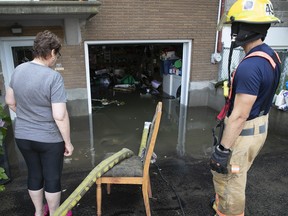The first thing you should do is make sure everyone is safe, then try to limit the damage by moving valuables.

Article content
As climate change increases the frequency of heavy downpours, Montreal homeowners may eventually deal with the unfortunate burden of flooding.
Water damage is already the most common disaster home insurance companies deal with, and it’s only becoming more frequent, according to CAA-Québec — but there are some things you can do to protect your home as well as ways to limit the damage if a flood occurs.
Advertisement 2
Story continues below
Article content
“The maintenance of the house is key,” said CAA-Québec damage insurance adviser Dominique Larouche.
When it comes to rain, that includes making sure there’s a slope around the property so the water drains away from the house, and that gutters are clean.
“It seems like nothing, but a blocked rain gutter can result in the water infiltrating the roof in many areas,” Larouche said.
Additionally, Intact Financial Corporation suggests removing debris from storm drains near your home; cleaning out your backwater valve; testing your sump pump; checking for leaks in plumbing, fixtures and appliances; removing obstruction from your flood drain; and storing valuables and hazardous materials in watertight containers.
If your house does flood, the first thing you should do is make sure everyone is safe, Larouche said. You can call emergency services to find out if you should turn off your power, or if they should do it for you.
“If you want to turn off the electricity, you have to make sure not to have both feet in the water, so firefighters could tell you what to do,” Larouche said.
Article content
Advertisement 3
Story continues below
Article content
Then, she added, from an insurance point of view, the goal is to limit the damage, if at all possible.
“If the problem is linked to the water entry point, then turn (it) off — that’s the first thing,” Larouche said. “Place personal objects of value higher up, or in rooms that aren’t flooded.”
Intact said to make a list — and take photos of — damaged items.
“If the home has become uninhabitable due to the damage, hold onto receipts for any reasonable increase in living expenses,” spokesperson David Barrett said in an email.
Depending on the severity of the flood, it’s possible your borough or city will set up temporary services for affected citizens, including temporary shelters or day centres. Sébastien Roy, head of Montreal’s civil security division, suggests subscribing to “Notices and Alerts” on the city’s website.
“They’ll receive all communications that are linked to the emergency situation,” he said. “There could be communications that will inform them on actions put in place by the agglomeration.”
Even if the flooding seems minor, Larouche said you should alert your insurer, as they’ll be able to guide you to determine if the damage is significant enough to make a claim — which isn’t always obvious to the naked eye.
Advertisement 4
Story continues below
Article content
“(Water) can enter the walls and infiltrate and damage the insulation,” Larouche said. “There are pipes that go through walls, all the ventilations systems … frankly, visually, it’s hard to evaluate.”
Depending on the situation, the insurer may send over a team to evaluate the house, cleaning services or ventilators to dry out the space.
“These are all elements that the insurer can explain depending on the nature of the flood,” Larouche said.
She added from the start, homeowners should make sure they understand their insurance contracts, because not all of them include coverage for every type of flood.
“It’s possible that (things aren’t in the contract),” Larouche said. “So ask the questions to ensure that you’re covered for a situation that you think can happen to you … make sure to have the right protections in the contract.”
According to the Insurance Bureau of Canada, the average cost of a claim as a result of water damage was just under $15,000 in Quebec in 2023.
Recommended from Editorial
Advertisement 5
Story continues below
Article content
Article content


Comments